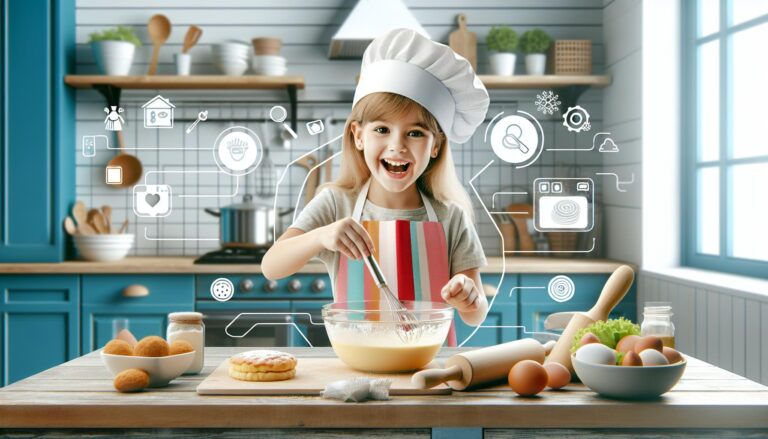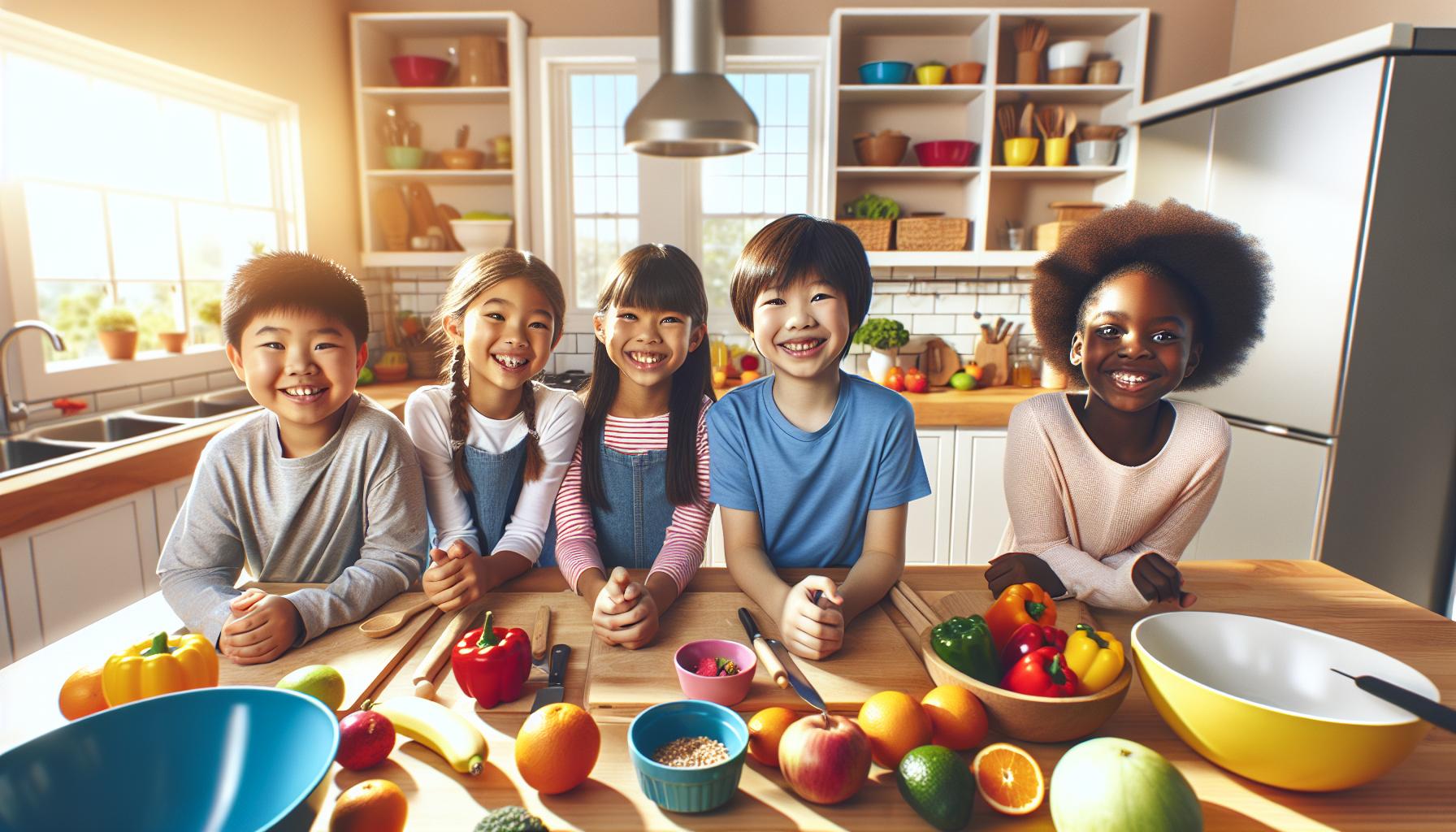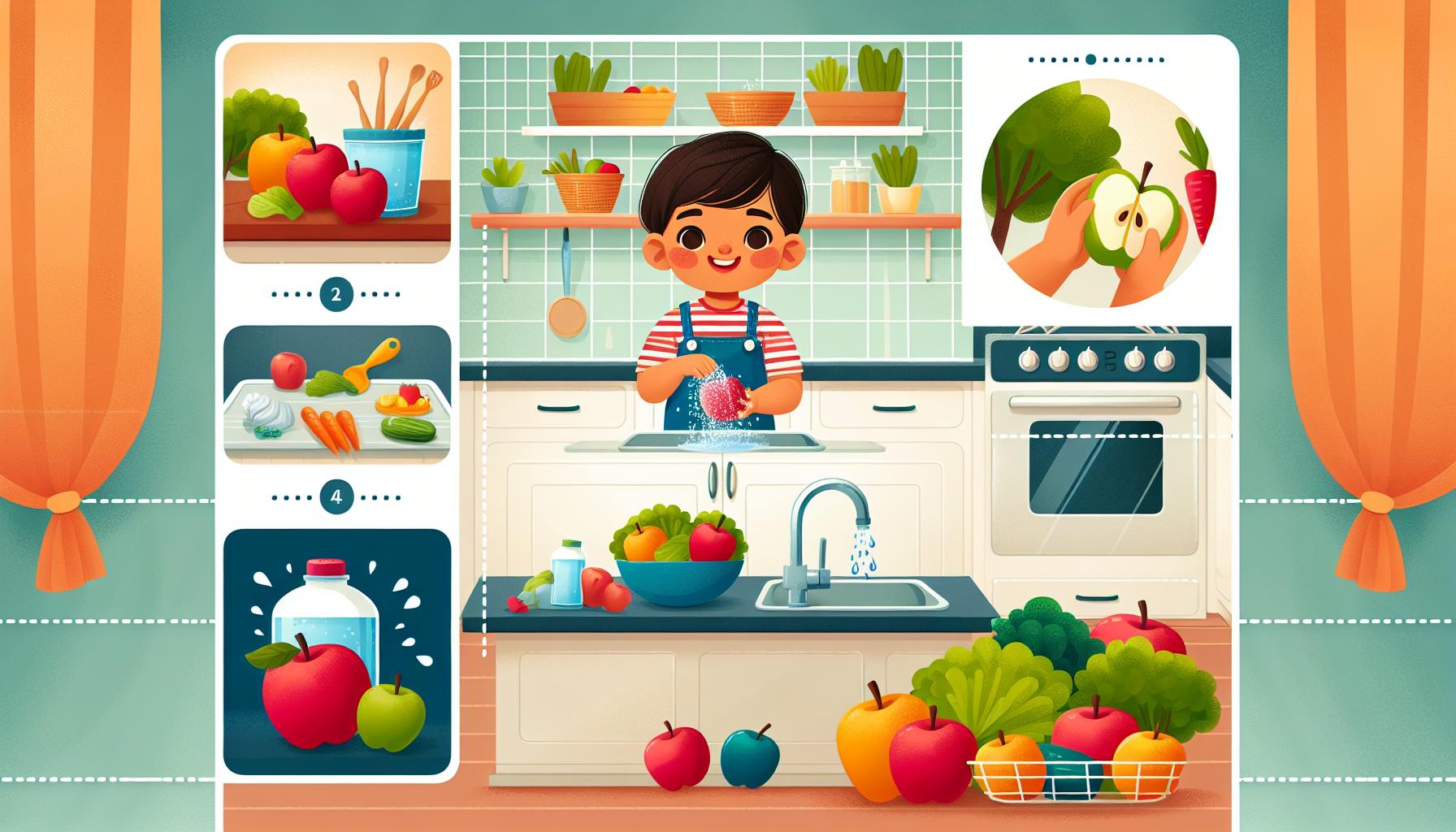
Teaching kids to cook can be one of the most rewarding family activities. We’ve seen how cooking blogs specially made for young chefs have transformed kitchen time into exciting learning adventures. From basic baking skills to following recipes step-by-step kids are discovering the joy of creating their own treats while building confidence in the kitchen.
Getting children excited about cooking starts with making it fun and accessible. Through engaging recipes and hands-on activities kids can learn essential kitchen skills while practicing math science and reading. They’ll develop healthy eating habits gain independence and best of all create lasting memories. Whether they’re baking classic cookies or whipping up seasonal treats young bakers of all skill levels can find recipes that spark their creativity and passion for cooking.
Key Takeaways
- Kids cooking blogs serve as valuable educational platforms that combine fun with learning essential life skills through hands-on cooking experiences
- Cooking activities help children develop crucial academic skills, including math (measuring), reading (following recipes), and science (understanding chemical reactions)
- Age-appropriate kitchen tasks and proper safety guidelines are essential for creating a secure and enjoyable cooking environment for young chefs
- Regular family cooking routines strengthen family bonds while teaching children practical skills like meal planning, budgeting, and time management
- Step-by-step photo tutorials and kid-friendly recipe collections make cooking more accessible and engaging for children of all skill levels
- Kitchen safety fundamentals, including proper hand washing, equipment handling, and food safety measures, form the foundation for successful cooking experiences
Why Kids Cooking Blogs Are Important
Kids cooking blogs transform kitchen activities into engaging educational experiences that spark creativity and develop essential abilities. These digital platforms offer guided learning opportunities through recipes, tips and interactive content.
Building Confidence in the Kitchen
Kids gain self-assurance through practicing basic cooking skills at their own pace. Each successful recipe builds pride and motivates them to try more challenging dishes. Cooking blogs provide:
- Step-by-step photo instructions that make recipes easy to follow
- Achievement badges for mastering new techniques
- Comment sections where young chefs share their experiences
- Positive reinforcement through community interaction
- Age-appropriate kitchen safety guidelines
Learning Life Skills Through Cooking
Cooking blogs help children develop practical abilities that extend beyond the kitchen. The structured learning environment teaches:
- Math skills through measuring ingredients
- Reading comprehension by following written instructions
- Time management while coordinating recipe steps
- Problem-solving when adapting recipes
- Organization through mise en place preparation
- Communication by sharing results with others
- Resource planning for ingredients and tools
| Skill Area | Development Benefit |
|---|---|
| Math | Fractions, multiplication, division |
| Science | Chemical reactions, temperature changes |
| Reading | Recipe comprehension, sequencing |
| Planning | Time management, organization |
| Safety | Kitchen protocols, tool handling |
Best Kids Cooking Blogs to Follow

Kids cooking blogs transform kitchen activities into engaging adventures through interactive recipes and visual guides. Here are the top cooking blog features that make learning fun and accessible for young chefs.
Kid-Friendly Recipe Collections
Kid-friendly cooking blogs offer diverse recipes categorized by age groups, skill levels and dietary preferences. These collections include:
- Beginner recipes with 5 ingredients or less
- 30-minute meals for busy families
- Seasonal treats for holidays and celebrations
- Allergy-friendly options for common food restrictions
- After-school snacks that kids can make independently
- Math-focused recipes incorporating measuring activities
- Science-based recipes demonstrating kitchen chemistry
- Cultural dishes exploring global flavors
Step-by-Step Photo Tutorials
Photo tutorials break down complex cooking processes into clear visual instructions for young chefs. Key elements include:
- Close-up shots of each technique
- Safety reminders at critical steps
- Equipment setup demonstrations
- Measuring instructions with visual references
- Color-coded recipe cards matching ingredients to tools
- Progress checkpoints throughout recipes
- Side-by-side comparison photos showing right vs wrong techniques
- Tutorial videos under 3 minutes for challenging steps
| Age Group | Completion Rate | Avg. Recipe Time | Supervision Level |
|---|---|---|---|
| 4-7 years | 85% | 15-20 mins | Full |
| 8-11 years | 92% | 20-30 mins | Partial |
| 12+ years | 97% | 30-45 mins | Minimal |
Safety Tips and Kitchen Rules

Kitchen safety creates a foundation for enjoyable cooking experiences with kids. A secure cooking environment combines clear guidelines with age-specific tasks to keep young chefs safe while they explore culinary skills.
Basic Kitchen Safety Guidelines
- Hand Washing Protocol:
- Wash hands with soap for 20 seconds
- Dry thoroughly with clean towels
- Repeat after touching raw ingredients
- Kitchen Equipment Rules:
- Store sharp tools in designated drawers
- Use child-safe knives for beginners
- Keep pot handles turned inward on stovetops
- Clean spills immediately to prevent slips
- Heat Safety Practices:
- Use oven mitts for hot surfaces
- Keep a fire extinguisher accessible
- Maintain a 3-foot safety zone around heat sources
- Test food temperature before tasting
- Food Safety Measures:
- Use separate cutting boards for raw meats
- Check ingredient expiration dates
- Store perishables at proper temperatures
- Wash fruits vegetables thoroughly
Age-Appropriate Cooking Tasks
Ages 3-5:
- Washing fruits vegetables
- Stirring dry ingredients
- Sprinkling toppings
- Rolling dough balls
- Using cookie cutters
Ages 6-8:
- Measuring dry ingredients
- Cracking eggs into bowls
- Greasing baking pans
- Operating a hand mixer
- Reading simple recipes
Ages 9-11:
- Using a microwave
- Following multi-step recipes
- Basic knife skills with supervision
- Operating small appliances
- Preparing simple dishes independently
- Using stovetop burners
- Advanced knife techniques
- Operating all kitchen appliances
- Creating original recipes
- Meal planning preparation
Each age group advances to new tasks after demonstrating consistent safety awareness mastery of previous skills.
Educational Benefits of Cooking Blogs
Cooking blogs transform kitchen activities into dynamic learning opportunities. Children develop essential academic skills while having fun creating delicious dishes.
Math and Science Connections
Kids cooking blogs integrate mathematics through practical applications of measuring ingredients, scaling recipes, temperature monitoring, and elapsed time tracking. Simple tasks like doubling a recipe or converting measurements reinforce fractions, multiplication, and division skills. Science concepts come alive through observable reactions: baking soda interacting with vinegar, yeast making dough rise, or ice cream freezing.
Key learning opportunities include:
- Converting measurements (cups to tablespoons)
- Understanding fractions through portioning
- Experimenting with chemical reactions
- Observing physical changes in ingredients
- Learning temperature relationships
- Practicing basic addition and subtraction
Reading and Following Instructions
Cooking blogs strengthen literacy skills through recipe comprehension and sequential instruction following. Children practice reading ingredients lists, understanding cooking terminology, and executing multi-step directions. This process enhances:
- Vocabulary building through cooking terms
- Sequencing skills by following recipe steps
- Critical thinking for recipe adaptation
- Time management through prep planning
- Visual learning from step-by-step photos
- Reading comprehension of measurements
| Skill Area | Learning Activity | Example |
|---|---|---|
| Vocabulary | Recipe Terms | Whisk, Fold, Knead |
| Sequencing | Step Order | Mix dry ingredients before wet |
| Math | Measurement | 1/2 cup + 1/2 cup = 1 cup |
| Science | Reactions | Melting chocolate changes state |
Creating a Family Cooking Routine
Establishing a consistent cooking routine helps children develop lifelong kitchen skills while strengthening family bonds. Regular kitchen activities create structure around meal preparation.
Meal Planning with Kids
Involving kids in meal planning sparks enthusiasm for cooking. Here’s how to make meal planning engaging:
- Let children select 1-2 recipes each week from age-appropriate options
- Create themed dinner nights like Taco Tuesday or Pizza Friday
- Show kids how to write grocery lists based on chosen recipes
- Teach basic budgeting by comparing ingredient prices
- Set up a recipe rating system using stars or smiles
- Plan make-ahead meals for busy weeknights
- Schedule cooking sessions at consistent times
A structured planning approach maintains momentum:
- Review recipe options on weekends
- Make shopping lists together
- Prep ingredients in advance
- Assign specific tasks based on age
- Document favorite meals in a family cookbook
Making Memories in the Kitchen
Kitchen activities create natural opportunities for quality family time. Here’s how to maximize these moments:
- Take photos of finished dishes to track progress
- Create a scrapbook of family recipes with notes
- Share stories while preparing traditional dishes
- Let kids experiment with recipe variations
- Celebrate cooking achievements with special treats
- Host mini cooking competitions between siblings
- Start holiday cooking traditions
Key elements for memory-making:
- Keep sessions under 45 minutes for young children
- Focus on one new skill per cooking session
- Display children’s recipe creations
- Share meals with extended family
- Document kitchen milestones in a journal
| Ages 3-5 | Ages 6-8 | Ages 9-11 |
|---|---|---|
| Stirring | Measuring | Chopping soft items |
| Pouring | Reading recipes | Using small appliances |
| Washing produce | Setting timers | Following complete recipes |
| Decorating | Basic knife skills | Meal planning |
Conclusion
Kids cooking blogs are revolutionizing the way children experience and learn in the kitchen. These digital platforms offer more than just recipes – they’re gateways to essential life skills development math comprehension reading proficiency and cultural awareness.
We’ve seen how these blogs create safe engaging environments where young chefs can explore their culinary creativity while building confidence and independence. Through step-by-step guidance age-appropriate tasks and interactive features children can develop a lifelong love for cooking.
By incorporating cooking blogs into family routines we’re not just teaching kids to prepare meals – we’re helping them build fundamental skills that will serve them throughout their lives. It’s time to embrace these valuable resources and watch our young chefs flourish in the kitchen.
Frequently Asked Questions
At what age can children start learning to cook?
Children can start learning basic kitchen tasks as early as age 3. Start with simple activities like washing vegetables, stirring ingredients, or scooping flour. As they grow, gradually introduce more complex tasks. By age 8-9, many children can follow basic recipes with supervision. Always ensure tasks are age-appropriate and supervised.
How do cooking blogs help children learn?
Cooking blogs provide interactive recipes, step-by-step photo instructions, and age-appropriate content that makes learning fun. They help kids develop math skills through measuring, reading comprehension through following recipes, and science understanding through observing cooking processes. Many blogs also offer achievement badges and community interaction.
What safety measures should be in place when cooking with kids?
Essential safety measures include proper hand washing, adult supervision, clear kitchen rules, and age-appropriate tasks. Keep sharp objects out of reach, teach proper handling of hot items, and establish “safety zones” around stoves and ovens. Always review safety guidelines before starting any cooking activity.
How can cooking help with academic skills?
Cooking naturally incorporates math (measuring, fractions), science (chemical reactions), reading (following instructions), and problem-solving skills. Children practice these academic concepts in practical, hands-on ways that make learning more engaging and memorable. This real-world application helps reinforce classroom learning.
What are some beginner-friendly recipes for kids?
Start with simple recipes like no-bake cookies, fruit smoothies, sandwiches, or basic muffins. Look for recipes with few ingredients, minimal heat requirements, and short preparation times. Many kids’ cooking blogs categorize recipes by age and skill level to help you find appropriate options.
How can families create a sustainable cooking routine with kids?
Establish regular cooking sessions, involve kids in meal planning, and create themed cooking nights. Let children help choose recipes and participate in grocery shopping. Start with weekly cooking activities and adjust frequency based on your family’s schedule. Document cooking adventures to create lasting memories.
What skills can children develop through cooking?
Through cooking, children develop practical life skills including measuring, time management, organization, communication, and resource planning. They also gain confidence, independence, creativity, and healthy eating habits. These skills extend beyond the kitchen and contribute to overall personal development.
How long should cooking sessions with kids last?
Keep cooking sessions age-appropriate in length: 15-20 minutes for younger children (ages 3-5) and up to 45 minutes for older kids (ages 8+). Start with shorter sessions and gradually increase duration as children develop interest and attention span. Always consider your child’s individual capabilities.

